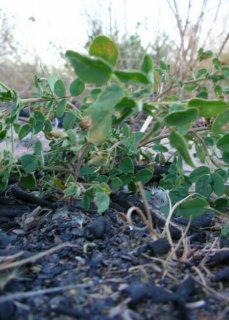 What’s blooming: Except for sweet alyssum in a pot and two purple asters near a wall, the flowers are gone, and along with them, the insects and other animals that fed on them. The active animals have turned to seeds, roots, winter annuals, and evergreens.
What’s blooming: Except for sweet alyssum in a pot and two purple asters near a wall, the flowers are gone, and along with them, the insects and other animals that fed on them. The active animals have turned to seeds, roots, winter annuals, and evergreens.What’s green in the area: Alfilerillo; grasses, including needle grass and June grass; yucca, yew, juniper, piñon, and other pines. Arborvitae is skimmed in yellow.
What’s green in my yard: Coral beardtongue, snapdragons, columbine, roses, bouncing Bess, large flowered soapwort, sweet peas, sweet white clover, baptista, salvia, Romanian sage, thrift, rockrose, winecup, hollyhock, red and blue flax, pink and yellow evening primrose, hartwegia, iris, red hot poker, catmint, California poppy, vinca, tansy, Frikarti and golden hairy asters, tahokia daisy, Mexican hat, coreopsis, black-eyed Susan, chocolate flower, perky Sue, wild lettuce, mums, yarrow.
What’s grey: Snow-in-summer, pinks, buddleia, yarrow, four-winged salt bush.
What’s red: Barberry, coral bells, pinks, small flowered soapwort, white and blue beardtongues, cholla.
Animal sightings: A few surviving grasshoppers; birds around fence and trees; gopher dug more dirt near the sour cherry; something knocked bricks from the lining walls along the garden.
Weather: Clear days, bright stars, no moisture since 15 October.
Weekly update: Saturday was burn day in the valley. I saw five plumes of smoke along the main road in the morning, and noticed two others collecting dead weeds for pyres.
The man behind me at the post office said he was ready to burn his fields, which he likes to do every two years to eliminate mats. The grass comes back and the alfalfa’s not harmed.
I’m much more conservative about burning, probably because I come from Michigan where we were trained to build rock circles around cook fires. At one summer camp, the leader made us line the bottom as well, lest we ignite the peat. That seemed extreme to this teenager, but I’ve been told a peat fire has been smoldering northeast of town for several years.
On a still, cloudy day this July I found a place in my drive that was wet and laid down a long cardboard box that had held a sapling. I piled old financial papers in the box, turned on the hose and lit a match.
While the papers were burning, I cut down 5' high white sweet clover plants from last summer and fed them to the flames. Then I added other dead plants from the drive and rosewood cuttings I hadn’t taken out yet for the trashmen.
As the fire burned, plants in the area would catch. I protected the asters and grasses, but let the rest go, the yellowbrush, winterfat and clover that had invaded the gravel. I rather hoped the heat would kill them.
I’m quite willing to let white sweet clover grow in the yard, but its branches scratch the fence when they dry in winter. Unfortunately, Melilotus Alba needs water and chooses my garden. Yellow sweet clover, Melilotus Officinalis, is the one that grows along the shoulders until it’s mown down in late summer before it reaches its full height.
When I got home yesterday I saw the clover still growing amid the charred remains in my drive. The European native thrives on fire, and only starts to die out when prairie fires stop and other plants take its resources. With no water, it can die out in three years.
I was fooled by the grasshoppers that chomped last year’s biennial seedlings. It was easy to cut any stalks before the spikes of tiny white flowers appeared. But, as soon as it rained in July, old seeds sprouted.
Rain is protective as well as nutritive. The taproots are long; I’ve pulled some that were close to 3' long. They can only be removed when the ground is wet, which is often when it has already produced its tiny seeds. The trefoil seedlings are tedious to pull and impossible to poison in the rain.
White sweet clover was officially introduced into this country by Henry Tutwiler who imported seed from Chile to grow at Green Springs Academy in Alabama in 1856. The legume’s roots add nitrogen and humus to the soil. Animals graze the plants in early spring and eat hay that has been cured enough to dissipate the bitter coumarin.
I assume the rancher prefers alfalfa for his horses. He complained someone from Colorado was peddling hay that horses wouldn’t eat and contained tumbleweed seeds. When I suggested it might work as straw, he said no, not with those seeds. Had to be burned.
Notes: United States Department of Agriculture, Forrest Service, Range Plant Handbook, 1937, republished by Dover Publications, 1988.
No comments:
Post a Comment